High-tech Sonata adds higher-tech Hybrid
By John Gilbert
As Yogi Berra might have said, if he looked out my kitchen window at the shiny new Hyundai Sonata awaiting me: “It’s deja vu all over again.”
It’s OK to quote Yogi, because faithful readers will note that I only recently had written about the newly redesigned 2020 Sonata, which gave us amazing fuel economy in the 40s on a trip across Minnesota, from Duluth to Brainerd and back. I loved the car, so I wasn’t upset when another one — a beautiful dark blue instead of the silver first one — was delivered. I was, however, curious to get a second Sonata so quickly. As I walked a full circle around the car, I got to the rear deckled, finally, and noticed one extra word on the right side: “Hybrid.”
Suddenly I understood, and looked forward to every second I could spend behind the wheel of that Sonata Limited Hybrid. Hyundai always likes to prove it can punch above its class, and the Sonata Hybrid might set new standards for bargain production. The base Sonata Hybrid starts at $35,300, and you have to add all sorts of options, like the Bose audio upgrade, the solar roof, and the inside ambient lighting, to get that sticker up over $40,000.That makes the non-hybrid Sonata a distinct bargain, but the Hybrid shares its dramatic lines and offers the highest of high-tech.
For the sticker price, you get the kind of gas mileage you want to write home about. The EPA estimates start with a city figure of 45 miles per gallon, with 51 in highway driving, for an overall average of 47. I am here to tell you that you can meet those figures if you drive the car hard, and if you drive judiciously you can easily surpass them. We found that, like most hybrids, you get better fuel economy in city driving, where you exploit every bit of electric energy. On the freeway, holding a steady 70 or 75, the gas engine will be working steadily, which uses more fuel.
We got 46.7 mpg on a trip from Duluth to Minneapolis and back, and the next day, driving up and down the hills of Duluth, I got it up to 62.1 mpg, a figure I found hard to believe.
Hyundai has built the midsize Sonata in Seoul, South Korea, for a couple decades, and rode its totally restructured and reengineered lines in 2011 to a new world of corporate achievement, from which it never looked back. A new engine and a home-built transmission in a slick new body on an all-new platform, turning out good power and great fuel efficiency at a moderate price — no wonder it shot up to the top, right there with Accord, Camry, Altima, Mazda6 and other Japanese standard-setters.
A completely new technique in engine-building powered the upsurge, and Hyundai applied that technology to all its engines, winning awards and customers by backing its cars and SUVs with a 10-year, 100,000-mile warranty. Next it built factories in the U.S., one in Montgomery, Alabama, for itself to build Sonatas and Santa Fe SUVs, and one a few hours to the North for its newly acquired partner, Kia, and between the two plants they built an engine plant, easily servicing both factories.
Now, almost a decade later, Sonata has proven it has maintained its stature, and now it is showing it has moved above and beyond its top Japanese rivals. Toyota, we know, set the standard for hybrid technology by installing nickel-metal-hydride battery packs under the very shallow trunk in its Prius. Hyundai learned from Toyota, then went a different direction.
In recenta company cal years, a hugely successful appliance company called LG Chem started developing a new style of battery pack for hybrid cars. General Motors used LG Chem for its Volt, and now its Bolt. Other companies used LG Chem also, and it has built an affiliate factory near Detroit to supply ever-increasing demand. Because it happens to be based in Seoul, South Korea, however, Hyundai built a long, close and nationalistic relationship with LG Chem. The biggest difference is that LG Chem built its batteries of Lithium-ion polymer, proving it to charge quicker, deliver more power and hold its charge longer than nickel-metal hydride. It also constructs the battery packs in a thin horizontal panel, which Hyundai placed on the platform, under the rear passenger seat, when it built the Ioniq compact sedans in hybrid, plug-in hybrid and pure electric.
That had an inherent advantage or two. One, it allowed for a large and spacious trunk, and two, by fitting under the rear seat, the battery pack is located ahead of the rear axle. That places the added weight of the battery pack between the two axles, which, whether by luck or brilliant design, mimics the handling of mid-engine performance cars. The Ioniq, and now the Sonata Hybrid, have startlingly quick steering, partly due to that balance.
To enhance that, the new Sonata design is definitely sporty looking, and Hyundai wisely added steering-wheel paddles to allow manual shifting of the slick, 6-speed automatic, designed and since refined in-house by Hyundai. I’m not sure about the other models, but the Limited is clearly aiming to capture buyers who prefer some luxury, and the dashboard and interior features, including heated and ventilated light tan leather seats in the test vehicle, certainly provided that.
All the other features that make the standard Sonata so impressive work in spades on the Hybrid, such as the slick lane-departure warning and assist, and the extra safety of the blind-spot warning works overtime to detect vehicles coming from the rear after you’ve parallel parked, preventing rear-seat passengers from opening the door into danger. It also allows you to code the car’s remote key features into your smartphone, which adds to capability to start your engine and unlock your doors at the touch of a phone screen switch.
The large 10.25-inch-wide navigation and information screen fits into the horizontal theme of the dash, and an option is a roof that replaces the sunroof with a large solar panel, which can turn sunlight into electric energy to replenish the batteries, and reportedly will add about two miles a day to your pure-electric driving range.
In a step toward too-much nanny-ism, the Sonata Hybrid’s features include a bit of intrigue, too. I wanted to move the car a few feet in our driveway so my wife, Joan, could pull our car out of its garage lair. So I climbed in, started the engine, but couldn’t get the shift to engage drive — or reverse, for that matter. After several minutes of thinking I had done something to foul up a really neat car, I realized that I hadn’t put my seat harness on. That proved to be true; if you don’t buckle up, you can’t put this car into gear!
The sweeping aerodynamic lines of the newly restyled Sonata undoubtedly help slice through the air, and the Sonata puts every bit of it to good use. Under the hood is a 2.0-liter, dual-overhead-camshaft 4-cylinder engine, built to operate on Atkinson Cycle, which leaves the valves closed or opened longer to enhance more complete burning of all the fuel. All cars would benefit by using the technique, except that it can make an engine feel a little hesitant.
To take care of that, Hyundai engineers augment the useful 150 horsepower and 139 foot-pounds of torque from the direct-injection 2.0 engine with a 270-volt LG Chem Lithium-ion polymer battery pack’s power — an impressive addition of electrical power, which peaks in torque from 0-1,800 RPMs, and increases the combined engine power to a potent 192 horsepower at 6,000 RPMs.
With all that’s going on under the hood, as a driver, you feel no complications, just smooth and uninterrupted power. You can push it into a corner, and the firm suspension and precise steering take you around even abrupt curves without drama, and the low-profile tires on those styled 17-inch “EcoSpoke” wheels coax the suspension into full duty.
As the test week went along, we found more and more features to appreciate, including the brilliant LED headlights and stylish taillight halo. Also, that accent light strip that underlines the headlights continues with diminishing LED glow as it follows up the seam between the hood and fenders.
My belief, since driving the first Honda and Toyota hybrids, is that we will all be driving electric cars someday, and testing the pure-electric Ioniq with its almost 175 miles of range between recharges, is pretty convincing. Meanwhile, hybrids or plug-in hybrids are the perfect way to cover the transition as we move from gas engines toward that EV future. The Sonata Hybrid has done nothing to alter my viewpoint. They don’t have a pure-electric Sonata yet, but when they do, I want to drive it.


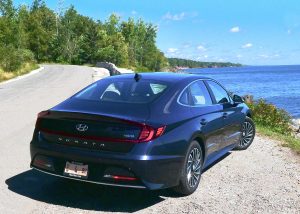
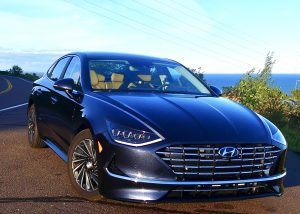
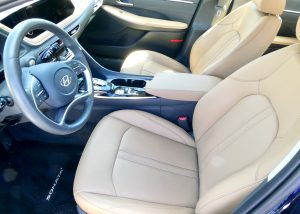
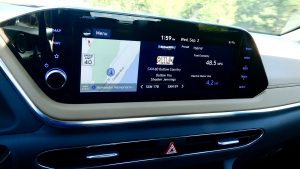
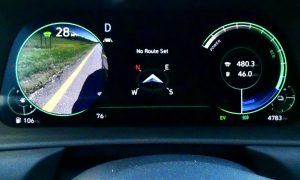
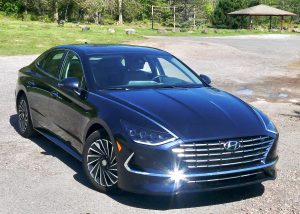
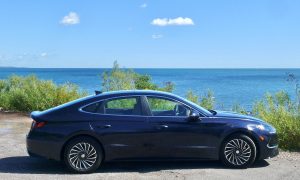
 John Gilbert is a lifetime Minnesotan and career journalist, specializing in cars and sports during and since spending 30 years at the Minneapolis Tribune, now the Star Tribune. More recently, he has continued translating the high-tech world of autos and sharing his passionate insights as a freelance writer/photographer/broadcaster. A member of the prestigious North American Car and Truck of the Year jury since 1993. John can be heard Monday-Friday from 9-11am on 610 KDAL(www.kdal610.com) on the "John Gilbert Show," and writes a column in the Duluth Reader.
John Gilbert is a lifetime Minnesotan and career journalist, specializing in cars and sports during and since spending 30 years at the Minneapolis Tribune, now the Star Tribune. More recently, he has continued translating the high-tech world of autos and sharing his passionate insights as a freelance writer/photographer/broadcaster. A member of the prestigious North American Car and Truck of the Year jury since 1993. John can be heard Monday-Friday from 9-11am on 610 KDAL(www.kdal610.com) on the "John Gilbert Show," and writes a column in the Duluth Reader.